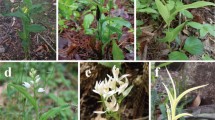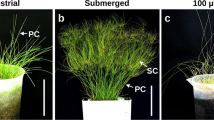Abstract
Family Chenopodiaceae is an intriguing lineage, having the largest number of C4 species among dicots, including a number of anatomical variants of Kranz anatomy and three single-cell C4 functioning species. In some previous studies, during the culture of Bienertia cycloptera Bunge ex Boiss., carbon isotope values (δ13C values) of leaves deviated from C4 to C3−C4 intermediate type, raising questions as to its mode of photosynthesis during growth in natural environments. This species usually co-occurs with several Kranz type C4 annuals. The development of B. cycloptera morphologically and δ13C values derived from plant samples (cotyledons, leaves, bracts, shoots) were analyzed over a complete growing season in a salt flat in north central Iran, along with eight Kranz type C4 species and one C3 species. For a number of species, plants were greenhouse-grown from seeds collected from the site, in order to examine leaf anatomy and C4 biochemical subtype. Among the nine C4 species, the cotyledons of B. cycloptera, and of the Suaeda spp. have the same respective forms of C4 anatomy occurring in leaves, while cotyledons of members of tribe Caroxyloneae lack Kranz anatomy, which is reflected in the δ13C values found in plants grown in the natural habitat. The nine C4 species had average seasonal δ13C values of −13.9‰ (with a range between species from −11.3 to −15.9‰). The measurements of δ13C values over a complete growing season show that B. cycloptera performs C4 photosynthesis during its life cycle in nature, similar to Kranz type species, with a seasonal average δ13C value of −15.2‰.





Similar content being viewed by others
Abbreviations
- δ13C values:
-
Carbon isotope values
- NAD-ME:
-
NAD-Malic enzyme
- NADP-ME:
-
NADP-Malic enzyme
- PEP-CK:
-
Phosphoenolpyruvate carboxykinase
- PEPC:
-
Phosphoenolpyruvate carboxylase
- PPFD:
-
Photosynthetic photon flux density
- Rubisco:
-
Ribulose bisphosphate carboxylase-oxygenase
- Ci/Ca ratio:
-
The relationship between the concentration of CO2 in the intercellular air space of the leaf and that in the atmosphere
- ϕ:
-
Percentage leakage of CO2 following decarboxylation of C4 acids in the C4 cycle
References
Akhani H (2006) Biodiversity of halophytic and sabkha ecosystems in Iran. In: Khan A, Böer B, Kust GS, Barth H-J (eds) Sabkha ecosystems: vol II: West and Central Asia. Springer, New York, pp 71–88
Akhani H, Ghasemkhani M (2007) Diversity of photosynthetic organs in Chenopodiaceae from Golestan National Park (NE Iran) based on carbon isotope composition and anatomy of leaves and cotyledons. Nova Hedw Suppl 131:265–277
Akhani H, Trimborn P, Ziegler H (1997) Photosynthetic pathways in Chenopodiaceae from Africa, Asia and Europe with their ecological, phytogeographical and taxonomical importance. Plant Syst Evol 206:187–221. doi:10.1007/BF00987948
Akhani H, Ghobadnejhad M, Hashemi SMH (2003) Ecology, biogeography and pollen morphology of Bienertia cycloptera Bunge ex Boiss. (Chenopodiaceae), an enigmatic C4 plant without Kranz anatomy. Plant Biol 5:167–178. doi:10.1055/s-2003-40724
Akhani H, Barroca J, Koteeva N, Voznesenskaya E, Franceschi V, Edwards GE, Ghaffari SM, Ziegler H (2005) Bienertia sinuspersici (Chenopodiaceae): a new species from Southwest Asia and discovery of a third terrestrial C4 plant without Kranz anatomy. Syst Bot 30:290–301. doi:10.1600/0363644054223684
Akhani H, Edwards G, Roalson EH (2007) Diversification of the Old World Salsoleae s.l. (Chenopodiaceae): molecular phylogenetic analysis of nuclear and chloroplast data sets and a revised classification. Int J Plant Sci 168:931–956. doi:10.1086/518263
Bender MM, Rouhani I, Vines HM, Black CC Jr (1973) 13C/12C ratio changes in Crassulacean acid metabolism plants. Plant Physiol 52:427–430
Boyd CN, Franceschi VR, Chuong SDX, Akhani H, Kiirats O, Smith M, Edwards GE (2007) Flowers of Bienertia cycloptera and Suaeda aralocaspica (Chenopodiaceae) complete the life cycle performing single-cell C4 photosynthesis. Funct Plant Biol 34:268–281. doi:10.1071/FP06283
Burnette WN (1981) “Western Blotting” Electrophoretic transfer of proteins from sodium dodecyl sulfate-polyacrylamide gels to unmodified nitrocellulose and radiographic detection with antibody and radioiodinated protein A. Anal Biochem 112:195–203. doi:10.1016/0003-2697(81)90281-5
Butnik AA (1974) Structural types of cotyledons in chenopods (Chenopodiaceae). Morphobiological features of wild-growing plants of Uzbekistan. FAN, Tashkent, pp 43–49
Butnik AA, Nigmanova RN, Paisieva SA, Saidov DK (1991) Ecological anatomy of desert plants of Middle Asia. V.1. Trees, shrubs, semi-shrubs. FAN, Tashkent
Butnik AA, Ashurmetov OA, Nigmatova RN, Paizieva SA (2001) Subshrubs, subshrublets, vol 2. FAN, Tashkent (in Russian)
Carolin RC, Jacobs SWL, Vesk M (1975) Leaf structure in Chenopodiaceae. Bot Jahrb Syst Pflanzengesch Pflanzengeogr 95:226–255
Cerling TE (1999) Paleorecords of C4 plants and ecosystems. In: Sage RF, Monson RK (eds) C4 Plant Biology. Academic Press, New York, pp 445–469
Chuong SDX, Franceschi VR, Edwards GE (2006) The cytoskeleton maintains organelle partitioning required for single-cell C4 photosynthesis in Chenopodiaceae species. Plant Cell 18:2207–2223. doi:10.1105/tpc.105.036186
Colombo SL, Andreo CS, Chollet R (1998) The interaction of shikimic acid and protein phosphorylation with PEP carboxylase from the C4 dicot Amaranthus viridis. Phytochemistry 48:55–59. doi:10.1016/S0031-9422(97)01100-X
Edwards GE, Franceschi VR, Voznesenskaya EV (2004) Single cell C4 photosynthesis versus the dual-cell (Kranz) paradigm. Annu Rev Plant Biol 55:173–196. doi:10.1146/annurev.arplant.55.031903.141725
Farquhar GD (1983) On the nature of carbon isotope discrimination in C4 species. Aust J Plant Physiol 10:205–226
Freitag H, Stichler W (2002) Bienertia cycloptera Bunge ex Boiss., Chenopodiaceae, another C4 plant without Kranz tissues. Plant Biol 4:121–132. doi:10.1055/s-2002-20444
Ghannoum O, Evans JR, Chow WS, Andrews TJ, Conroy JP, von Caemmerer S (2005) Faster Rubisco is the key to superior nitrogen-use efficiency in NADP-malic enzyme relative to NAD-malic enzyme C4 grasses. Plant Physiol 137:638–650. doi:10.1104/pp.104.054759
Henderson S, von Caemmerer S, Farquhar GD (1992) Short-term measurements of carbon isotope discrimination in several C4 species. Aust J Plant Physiol 19:263–285
Henderson S, von Caemmerer S, Farquhar GD, Wade L, Hammer G (1998) Correlation between carbon isotope discrimination and transpiration efficiency in lines of the C4 species Sorghum bicolor in the glasshouse and the field. Aust J Plant Physiol 25:111–123
Kadereit G, Borsch T, Weising K, Freitag H (2003) Phylogeny of Amaranthaceae and Chenopodiaceae and the evolution of C4 photosynthesis. Int J Plant Sci 164:959–986. doi:10.1086/378649
Kapralov MV, Akhani H, Voznesenskaya E, Edwards G, Franceschi VR, Roalson EH (2006) Phylogenetic relationships in the Salicornioideae/Suaedoideae/Salsoloideae sl (Chenopodiaceae) clade and a clarification of the phylogenetic position of Bienertia and Alexandra using multiple DNA sequence datasets. Syst Bot 31:571–585
Kubasek J, Setlik J, Dwyer S, Santrucek J (2007) Light and growth temperature alter carbon isotope discrimination and estimated bundle sheath leakiness in C-4 grasses and dicots. Photosynth Res 91:47–58. doi:10.1007/s11120-007-9136-6
Laemmli UK (1970) Cleavage of structural proteins during the assembly of the head of bacteriophage T4. Nature 227:680–685. doi:10.1038/227680a0
Long JJ, Wang J-L, Berry JO (1994) Cloning and analysis of the C4 photosynthetic NAD-dependent malic enzyme of amaranth mitochondria. J Biol Chem 269:2827–2833
Osmond C, Ziegler H, Stichler W, Trimborn P (1975) Carbon isotope discrimination in alpine succulent plants supposed to be capable of Crassulacean acid metabolism (CAM). Oecologia 28:323–328
Peisker M, Henderson SA (1992) Carbon: terrestrial C4 plants. Plant Cell Environ 15:987–1004. doi:10.1111/j.1365-3040.1992.tb01651.x
Pyankov VI, Kuzmin AN, Demidov ED, Maslov AI (1992) Diversity of biochemical pathways of CO2 fixation in plants of the families Poaceae and Chenopodiaceae from the arid zone of Central Asia. Sov Plant Physiol 39:411–420
Pyankov VI, Voznesenskaya EV, Kuz’min AN, Ku MSB, Ganko E, Franceschi VR, Black CC Jr, Edwards GE (2000a) Occurrence of C3 and C4 photosynthesis in cotyledons and leaves of Salsola species (Chenopodiaceae). Photosynth Res 63:69–84. doi:10.1023/A:1006377708156
Pyankov VI, Gunin PD, Tsoog S, Black CC (2000b) C4 plants in the vegetation of Mongolia: their natural occurrence and geographical distribution in relation to climate. Oecologia 123:15–31. doi:10.1007/s004420050985
Pyankov VI, Ziegler H, Kuz’min A, Edwards GE (2001) Origin and evolution of C4 photosynthesis in the tribe Salsoleae (Chenopodiaceae) based on anatomical and biochemical types in leaves and cotyledons. Plant Syst Evol 230:43–74. doi:10.1007/s006060170004
Sage RF (2004) The evolution of C4 photosynthesis. New Phytol 161:341–370. doi:10.1111/j.1469-8137.2004.00974.x
Sage RF, Li M, Monson RK (1999) The taxonomic distribution of C4 photosynthesis. In: Sage RF, Monson RK (eds) C4 Plant Biology. Academic Press, New York, pp 551–584
Saigo M, Bologna F, Maurino VG, Detarsio E, Andreo CS, Drincovich MF (2004) Maize recombinant non-C4 NADP-malic enzyme: a novel dimeric malic enzyme with high specific activity. Plant Mol Biol 55:97–107. doi:10.1007/s11103-004-0472-z
von Caemmerer S, Furbank RT (2003) The C4 pathway: an efficient CO2 pump. Photosynth Res 77:191–207. doi:10.1023/A:1025830019591
Voznesenskaya EV, Franceschi VR, Pyankov VI, Edwards GE (1999) Anatomy, chloroplast structure and compartmentation of enzymes relative to photosynthetic mechanisms in leaves and cotyledons of species in the tribe Salsoleae (Chenopodiaceae). J Exp Bot 50:1779–1795. doi:10.1093/jexbot/50.341.1779
Voznesenskaya EV, Artyusheva EG, Franceschi VR, Pyankov VI, Kiirats O, Ku MSB, Edwards GE (2001a) Salsola arbusculiformis, a C3–C4 intermediate in Salsoleae (Chenopodiaceae). Ann Bot (Lond) 88:337–348. doi:10.1006/anbo.2001.1457
Voznesenskaya EV, Franceschi VR, Kiirats O, Freitag H, Edwards GE (2001b) Kranz anatomy is not essential for terrestrial C4 plant photosynthesis. Nature 414:543–546. doi:10.1038/35107073
Voznesenskaya EV, Franceschi VR, Kiirats O, Artyusheva EG, Freitag H, Edwards GE (2002) Proof of C4 photosynthesis without Kranz anatomy in Bienertia cycloptera (Chenopodiaceae). Plant J 31:649–662. doi:10.1046/j.1365-313X.2002.01385.x
Voznesenskaya EV, Edwards GE, Kiirats O, Artyusheva EG, Franceschi VR (2003) Development of biochemical specialization and organelle partitioning in the single celled C4 system in leaves of Borszczowia aralocaspica (Chenopodiaceae). Am J Bot 90:1669–1680. doi:10.3732/ajb.90.12.1669
Voznesenskaya EV, Koteyeva NK, Chuong SDX, Edwards GE, Akhani H, Franceschi VR (2005) Differentiation of cellular and biochemical features of the single-cell C4 syndrome during leaf development in Bienertia cycloptera (Chenopodiaceae). Am J Bot 92:1784–1795. doi:10.3732/ajb.92.11.1784
Voznesenskaya EV, Franceschi VR, Chuong SDX, Edwards GE (2006) Functional characterization of phosphoenolpyruvate carboxykinase-type C4 leaf anatomy: Immuno-, cytochemical and ultrastructural analyses. Ann Bot (Lond) 98:77–91. doi:10.1093/aob/mcl096
Voznesenskaya EV, Chuong S, Koteyeva N, Franceschi VR, Freitag H, Edwards GE (2007) Structural, biochemical and physiological characterization of C4 photosynthesis in species having two vastly different types of Kranz anatomy in genus Suaeda (Chenopodiaceae). Plant Biol 9:745–757. doi:10.1055/s-2007-965579
Voznesenskaya EV, Akhani H, Koteyeva NK, Chuong SDX, Roalson EH, Kiirats O, Franceschi VR, Edwards GE (2008) Structural, biochemical and physiological characterization of photosynthesis in two C4 subspecies of Tecticornia indica and the C3 species Tecticornia pergranulata (Chenopodiaceae). J Exp Bot 59:1715–1734. doi:10.1093/jxb/ern028
Walker RP, Achenson RM, Tecsi LI, Leegood RC (1995) Phosphoenolpyruvate carboxykinase in C4 plants: purification from cucumber and evidence of rapid protelolytic cleavage on extracts from a range of plant-tissues. Planta 196:58–63. doi:10.1007/BF00193217
Walter H, Lieth H (1967) Klimadiagramm-Weltatlas. Gustav Fischer, Jena
Acknowledgments
This material is based, in part, on work supported by the research project Geobotanical Studies in Different Parts of Iran (6104037/01), a grant from the Research Council, University of Tehran to H. Akhani for sabbatical study, and the National Science Foundation under Grant no. IBN−0641232 to G.E. A large part of the isotope analysis was kindly provided through the valuable assistance of Dr. C. Deigele and Dipl. Eng. P. Trimborn, GSF National Research Center for Environment and Health, Munich, Germany. M.V. Lara is a Researcher Career Member of the Consejo Nacional de Investigaciones Científicas y Técnicas, Argentina. We acknowledge the Franceschi Imaging and Microscopy Center, Washington State University, for use of facilities and the advice of the staff for anatomical studies, C. Cody, for plant growth management, and Mr. M. Djamali for providing the map in Fig. 1.
Author information
Authors and Affiliations
Corresponding authors
Electronic supplementary material
Below is the link to the electronic supplementary material.
Rights and permissions
About this article
Cite this article
Akhani, H., Lara, M.V., Ghasemkhani, M. et al. Does Bienertia cycloptera with the single-cell system of C4 photosynthesis exhibit a seasonal pattern of δ13C values in nature similar to co-existing C4 Chenopodiaceae having the dual-cell (Kranz) system?. Photosynth Res 99, 23–36 (2009). https://doi.org/10.1007/s11120-008-9376-0
Received:
Accepted:
Published:
Issue Date:
DOI: https://doi.org/10.1007/s11120-008-9376-0




